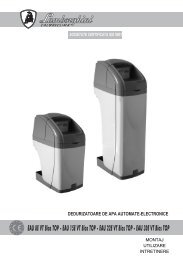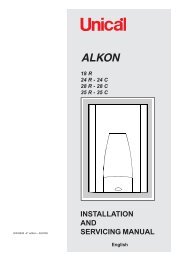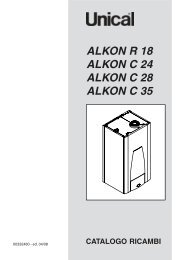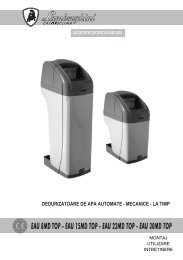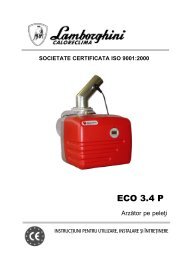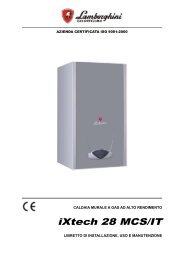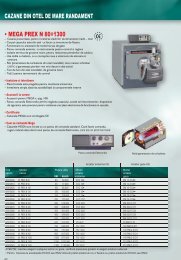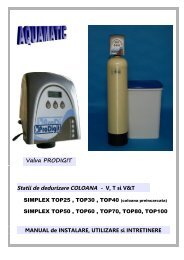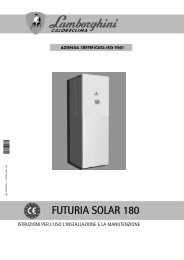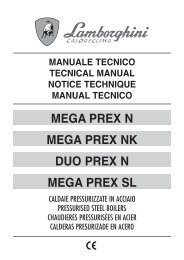product
TAHITI DUAL - Termoplus
TAHITI DUAL - Termoplus
- No tags were found...
You also want an ePaper? Increase the reach of your titles
YUMPU automatically turns print PDFs into web optimized ePapers that Google loves.
3.2.4. Installing the boiler<br />
Before connecting the boiler to the CH and DHW systems, clean the pipes carefully.<br />
Prior to operating a NEW system, eliminate any metallic leftover during manufacturing and welding process, and any<br />
oil or grease deposits, which might get into the boiler and damage it or affect operation.<br />
Prior to operating an UPGRADED system (addition of radiators, boiler replacement, etc.), clean it thoroughly to remove<br />
all sludge and foreign particles. Clean the system using a non-acid <strong>product</strong> available on the market.<br />
Do not use solvents as they could damage the components of the system.<br />
In the (new or upgraded) central heating system, it is always advisable to add to the water, in a suitable concentration, a<br />
corrosion inhibiting <strong>product</strong> for use in multi-metal systems to produce a protective film on internal metal surfaces.<br />
The Manufacturer can not be held liable for injury to people or animals or damage to property resulting from failure to<br />
follow the above instructions.<br />
Proceed as follows to install the boiler:<br />
• Fix the template (pic. 10) onto the wall.<br />
• Drill two 12 mm Ø holes in the wall to accommodate the boiler bracket wall plugs.<br />
• Arrange air intake/flue gas system in the wall as needed.<br />
• Secure the boiler bracket to the wall using the wall plugs supplied.<br />
• Position the gas supply fitting (G), the mains water fitting (F), the DHW flow fitting (C, only in model C), the CH flow fitting (M) and the CH<br />
return fitting (R) as shown on the template (refer to the lower part).<br />
• Provide a disposal system for relieving the 3-bar safety valve.<br />
• Hang the boiler on the bracket fixed onto the wall.<br />
• Connect the boiler to the mains pipes using the kit supplied with the boiler (refer to subsections 3.2.9. and 3.2.10).<br />
• Connect the boiler to the air intake and flue gas exhaust system (refer to subsections 3.2.6. and 3.2.7).<br />
• Connect the power supply, room thermostat (optional) and other accessories (refer to the following subsections).<br />
3.2.5. Boiler room ventilation<br />
It is mandatory to install the boiler in a suitable room in accordance with the applicable laws and standards in the<br />
country of installation, which are considered as fully transcribed in this manual.<br />
Model TN boilers have an open combustion chamber and can be connected to a chimney. Combustion air is drawn from the room where the<br />
boiler is installed.<br />
Model TFS boilers have a sealed combustion chamber. Combustion air is not drawn from the boiler room, so it is not necessary to follow specific<br />
recommendations concerning openings and ventilation, which are required in the event of depleted room air, or boiler room requirements.<br />
3.2.6. Air intake/flue gas system of natural draught boilers<br />
Flue gas discharge into the atmosphere must comply with applicable laws and standards in the country of installation.<br />
The boiler is fitted with an automatic reset safety device that prevents flue gas leakage into the boiler room (see<br />
subsection 1.3.3).<br />
Tampering with and deactivating the safety device are absolutely forbidden.<br />
If the boiler shuts down frequently due to a malfunction, check the flue gas discharge system.<br />
It may be clogged or inappropriate for discharging flue gas into the atmosphere.<br />
Connection to the chimney<br />
The chimney is an essential component for correct boiler operation. It must therefore comply with the following requirements:<br />
• it must be made of waterproof material and be resistant to flue gas temperature and condensate;<br />
• it must have appropriate mechanical characteristics and low thermal conductivity;<br />
• it must be perfectly sealed;<br />
• it must be positioned as vertical as possible and the roof terminal must have a cap ensuring efficient and constant flue gas discharge;<br />
• the chimney diameter must be as large as the diameter of the boiler flue gas outlet; square or rectangular section chimneys must have an<br />
internal cross-section 10% larger than that of the boiler flue gas outlet;<br />
• the pipe connecting the boiler to the chimney must be vertical and the length must be no less than twice its diameter before joining the<br />
chimney.<br />
22



